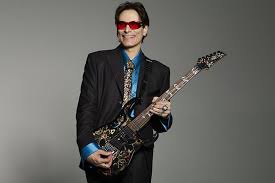So much to say about this fabulous guitarist! I first started getting into him after he released Passion and Warfare, around 1990. Only a few years into guitar playing, I was just starting to move out of the classic rock phase of players (Hendrix, Paige, Santana) and into some of the headier “rock-fusion” guys a la Satriani, Eric Johnson, etc. This particular album just blew my mind! It was such a newer, creative approach to guitar music and also full of really intelligent compositions. It’s obvious that Vai is extremely knowledgeable in the world of music theory, but what really catches the ear is the flamboyant technical wizardry he exhibits on the fretboard combined with the originality of the tones he creates, some of which sound nothing like the guitar at all! Like Hendrix, he seems to be connected spiritually to the guitar.
Steve Vai was first introduced to the guitar at age 6 and remembers it being the “coolest thing he had ever seen”. At around age 13, he began taking lessons from none other than Joe Satriani and only five years later was attending the Berkeley College of Music in Boston. Berkeley is where he first hooked up with Frank Zappa. Although only a transcriptionist at first, it only took a few semesters before he moved out to California and joined the band full time. Several years later, he built his first home studio in Sylmar, where he recorded his first solo album “Flex-able.”
Vai got another big break in 1989 when he joined David Lee Roth’s solo project as the lead guitarist. The band, consisting of Billy Sheehan on bass and Maynard Ferguson on drums, released their debut album, Eat ‘Em and Smile, which garnered quite a bit of critical acclaim for both the band and Steve Vai as a guitar player. They released a second album, Skyscraper, a few years later to equal success, but shortly thereafter Vai left the group in pursuit of his solo career. It was at this time when Steve started working on the JEM series 7-string guitars with Ibanez.
In 1990, he recorded and released the aforementioned Passion and Warfare album, the second album from his home studio. This album got the most attention from the guitar world and for good reason–it was sick! (Btw–Passion and Warfare has been cited as one of the most pertinent instrumental albums ever released.) At the same time he was recording parts for Whitesnake’s Slip of the Tongue album, while Adrian Vandenburg was recovering from an injury (a little know piece of trivia!). Shortly thereafter, he began writing with Ozzy Ozbourne on the album Ozzmosis, but unfortunately had to quit due to label conflicts. He went on to release several solo projects after that, including Alien Love Secrets and Fire Garden. These were departures from his normal, composition heavy material and even featured Vai on vocals on a few joints! In 2001 he released a ten CD set, The Secret Jewel Box, more of an homage to his fans which contained material from various time periods in Vai’s career.
To be honest, I kind of fell out of touch with Vai in the early 2000’s until I heard String Theory, circa 2007. Once again, Vai had turned up the creative flair, this time with another killer band that added dual violin/keyboardists to the mix. The music was intense and often featured Vai in long cape-like wizard outfits while he squeezed just about every sound out of the guitar one could imagine. It was great to watch the violin players flank Vai for various 3-part harmonies in the heads and solos, all while the bass and baritone guitarist would double the background metal riffs with amazing precision. This particular Steve Vai really reminded me of his early days, where he played the devil in the movie Crossroads (with Ralph Macchio). I still love going back and watching the live footage of this group!
Most recently I saw Vai with fellow guitarists Yngwie Malmsteen, Nuno Bettencourt, Zakk Wylde and Tosin Abasi in the 2016 Generation Axe concerts. The entire show was quite the spectacle, to say the least. However, Steve Vai was still killing it, showcasing his trademark skills and guitar noises. He even added a few new guitars to the mix–my favorite was the Ibanez lite-brite fretboard!
Steve Vai will always stand out as an original–not just for his insane guitar technique and sonic qualities, but for his contribution to guitar music in general. His songs are always intelligent and musical, adding a depth and richness that (imo) most guitar player’s albums are lacking. In addition, he brings a special energy to his playing (call it spiritual if you like) that is one of a kind. He really connects well with the instrument, almost as if it is an extension of his body. Most important is the passion that he brings to his work–it is really something to be admired! If you’ve made it this far in your guitar life without any Steve Vai, don’t fret–there is still time to absorb this incredible player. Any part of Steve’s career is exceptional, so dig in where you like!


Comments are closed.